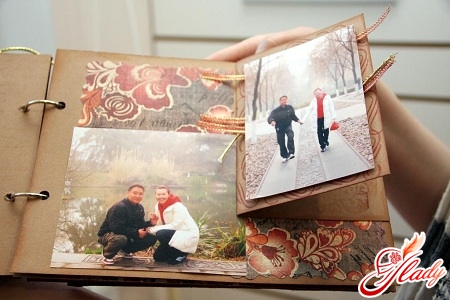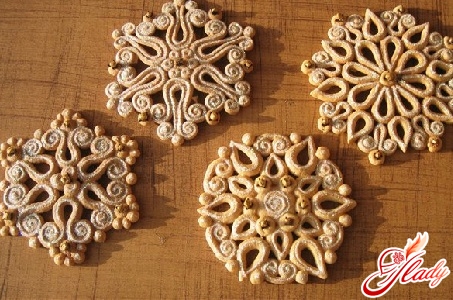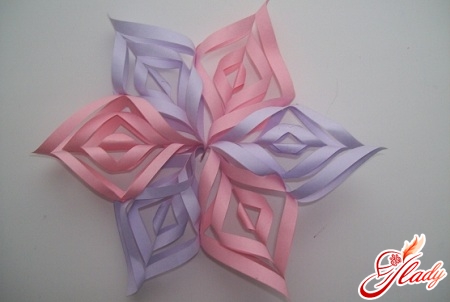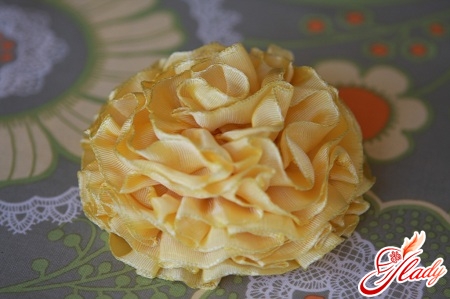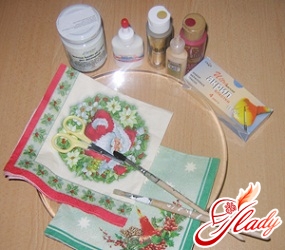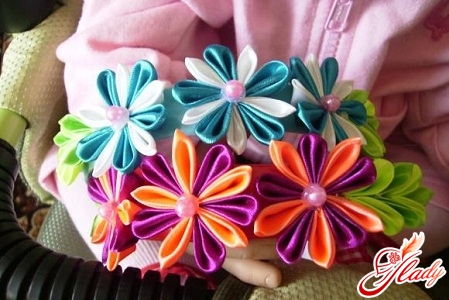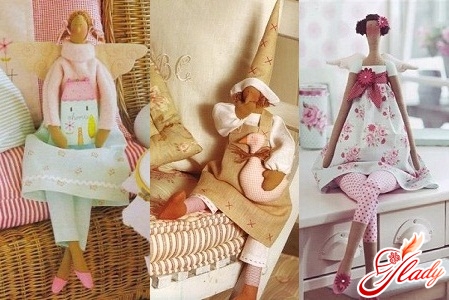 Tilda doll is a product of imagination and skillby Norwegian needlewoman Tone Finanger. Probably, when the Norwegian sewed her first doll, she could not even imagine that this was the beginning of the so-called "tildomania". Tilda dolls sewn in this technique (or even in this special style) quickly won fans all over the world immediately after the release of Tone Finanger's books "Tilda Christmas" and "Tilda Easter". And then the term Tilda began to be called not only dolls, but also all other toys: angels, rabbits, ballerinas, cats, teddy bears, flowers and the like. What was so special about this primitive doll? Why did it become so popular and fashionable? Is it easy to sew a Tilda doll with your own hands? Let's try to find answers to all these questions.
Tilda doll is a product of imagination and skillby Norwegian needlewoman Tone Finanger. Probably, when the Norwegian sewed her first doll, she could not even imagine that this was the beginning of the so-called "tildomania". Tilda dolls sewn in this technique (or even in this special style) quickly won fans all over the world immediately after the release of Tone Finanger's books "Tilda Christmas" and "Tilda Easter". And then the term Tilda began to be called not only dolls, but also all other toys: angels, rabbits, ballerinas, cats, teddy bears, flowers and the like. What was so special about this primitive doll? Why did it become so popular and fashionable? Is it easy to sew a Tilda doll with your own hands? Let's try to find answers to all these questions.
The Secret of the Birth of Tilda
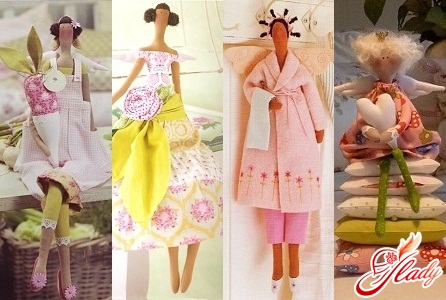 The creator of this primitive cutie is still quiteyoung girl. She says that her inspiration came from working in a shop that sold handicrafts. Tone Finanger's first impulse was to write children's books and create cartoons. However, the world of handicrafts captivated the artist so much that she came up with Tilda. According to Tone, Scandinavian folklore and childhood memories served as a source of inspiration. Soon after (in 1999), Tone wrote a book about her hobby, signed a contract for its publication and opened her first shop. And the following year, Panduro Hobby began releasing products under the Tilda brand. The resounding success of the books and handicrafts made Tone Finanger and her Tilda doll famous. Tilda's incredible popularity resulted in a real design concept, according to which several styles are combined in interior design, and the Tilda doll itself turned from a simple toy into an interior doll.
The creator of this primitive cutie is still quiteyoung girl. She says that her inspiration came from working in a shop that sold handicrafts. Tone Finanger's first impulse was to write children's books and create cartoons. However, the world of handicrafts captivated the artist so much that she came up with Tilda. According to Tone, Scandinavian folklore and childhood memories served as a source of inspiration. Soon after (in 1999), Tone wrote a book about her hobby, signed a contract for its publication and opened her first shop. And the following year, Panduro Hobby began releasing products under the Tilda brand. The resounding success of the books and handicrafts made Tone Finanger and her Tilda doll famous. Tilda's incredible popularity resulted in a real design concept, according to which several styles are combined in interior design, and the Tilda doll itself turned from a simple toy into an interior doll.
The secret of Tilda's fascination
Tone Finanger says that she herself adoresTilda for her extraordinary femininity and deliberate perfection. In her imagination, Tilda would easily leave the house dressed in a ball gown and rubber boots. Tilda would put roses in an old cracked jug, and a bouquet of weeds in a crystal vase. Tilda has a special idea of beauty; a serious outlook on life is impossible in her world. All Tone dolls are distinguished by their individuality. Each individual Tilda has a wayward character. Tilda is an adornment of life and an escape from the gray everyday life. What is the secret of Tilda dolls' charm? Apparently, it is in the deliberate primitiveness of execution, in the shy blush and beady eyes. The appearance of these dolls evokes a feeling of warmth, tenderness and comfort. Therefore, these unique dolls become keepers of the hearth and fashionable elements of the interior.
The secret of making Tilda
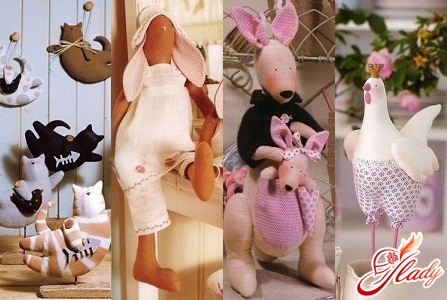 Tilda is very easy to make.And this is one of the reasons for its resounding success. It is not important to sew dolls by hand or use a sewing machine for this. Although handwork, oddly enough, looks neater. When creating tildiks (as they are called in Russia), natural cotton, linen or woolen fabrics are used. Flannel, fleece, calico, linen, cotton are well suited for lady dolls, as well as for animal dolls. These fabrics are taken to make the doll's body, which is dressed in clothes made of any fabric (chintz, silk, knitwear - whatever you like). The pattern of the fabric for the clothes can be any, but it must be small. Toys are mainly stuffed with synthetic padding or holofiber. Some individual parts of the body can be filled with fabric scraps or very finely chopped nylon tights (knee-highs). To weigh down the figurine, you can use calcined buckwheat. The legs of the young ladies dolls are sometimes stitched along the knee line - such legs will bend, and their owners will be able to sit even with their legs crossed. But it is important to remember that the legs in the hip area should not be stuffed tightly, otherwise they will not bend at the knees! After stuffing, the unstitched parts are stitched with a blind stitch. The hair of the Tilda doll is made of yarn. Plush yarn is suitable for the typical Tilda hairstyle. But any other yarn will also make a wonderful hairstyle for the Tilda hairstyle (especially if it is braids). The whiskers of cats, dogs and bunnies are made of thin wire, wrapping it with floss. The eyes of the Tildas are embroidered with French knots, or small dark beads are sewn on, or painted with acrylic paints. The blush required for these dolls is also applied with paints, either with regular dry blush or with slate powder from colored pencils. Another feature of Tildas is the color of the "skin". A real Tilda should look like a tanned girl. For this, use fabrics of a suitable color, or specially dyed. You can dye the fabric for Tilda's body with regular tea leaves or instant coffee. A piece of fabric that will go on the doll's body is boiled in dye for ten minutes and dried. Sometimes a ready-made toy is dyed. Then the tea (coffee) solution is made thicker, and for fixing I add a little PVA glue to it. But in this case, all sewn-on details, eyes, decorations, must be sewn on after dyeing the doll. Another solution for dyeing Tilda: 1 liter of water, 50 grams of instant coffee, 1 tablespoon of salt. In this solution, the fabric must be constantly stirred, then rinsed lightly in cool water. Dry the dyed fabric carefully, without bending, pulling it by one edge.
Tilda is very easy to make.And this is one of the reasons for its resounding success. It is not important to sew dolls by hand or use a sewing machine for this. Although handwork, oddly enough, looks neater. When creating tildiks (as they are called in Russia), natural cotton, linen or woolen fabrics are used. Flannel, fleece, calico, linen, cotton are well suited for lady dolls, as well as for animal dolls. These fabrics are taken to make the doll's body, which is dressed in clothes made of any fabric (chintz, silk, knitwear - whatever you like). The pattern of the fabric for the clothes can be any, but it must be small. Toys are mainly stuffed with synthetic padding or holofiber. Some individual parts of the body can be filled with fabric scraps or very finely chopped nylon tights (knee-highs). To weigh down the figurine, you can use calcined buckwheat. The legs of the young ladies dolls are sometimes stitched along the knee line - such legs will bend, and their owners will be able to sit even with their legs crossed. But it is important to remember that the legs in the hip area should not be stuffed tightly, otherwise they will not bend at the knees! After stuffing, the unstitched parts are stitched with a blind stitch. The hair of the Tilda doll is made of yarn. Plush yarn is suitable for the typical Tilda hairstyle. But any other yarn will also make a wonderful hairstyle for the Tilda hairstyle (especially if it is braids). The whiskers of cats, dogs and bunnies are made of thin wire, wrapping it with floss. The eyes of the Tildas are embroidered with French knots, or small dark beads are sewn on, or painted with acrylic paints. The blush required for these dolls is also applied with paints, either with regular dry blush or with slate powder from colored pencils. Another feature of Tildas is the color of the "skin". A real Tilda should look like a tanned girl. For this, use fabrics of a suitable color, or specially dyed. You can dye the fabric for Tilda's body with regular tea leaves or instant coffee. A piece of fabric that will go on the doll's body is boiled in dye for ten minutes and dried. Sometimes a ready-made toy is dyed. Then the tea (coffee) solution is made thicker, and for fixing I add a little PVA glue to it. But in this case, all sewn-on details, eyes, decorations, must be sewn on after dyeing the doll. Another solution for dyeing Tilda: 1 liter of water, 50 grams of instant coffee, 1 tablespoon of salt. In this solution, the fabric must be constantly stirred, then rinsed lightly in cool water. Dry the dyed fabric carefully, without bending, pulling it by one edge.
The secret of the multitude of Tilda
From the moment of my birth until todayTilda has changed a lot. Her appearance has been influenced by artists from different countries. Today, Tilda is not only an elegant young lady. Charming plump girls, funny babies, and all sorts of little animals (including kangaroos and dragons) are made using the Tilda doll technique. There are tildas in the form of gingerbread, flowers, Christmas candies, snowmen... In a word, the appearance of Tilda can be given to absolutely any souvenir or toy. They are all very different. But at the same time, they cannot be confused with any other textile toy. Special proportions and a combination of fabrics give a typical Tilda appearance to absolutely all products made using the technique invented by Tone Finanger. Very cute, having exclusively positive energy, dolls enliven our home (and our life) with fresh colors and good emotions.
Pattern of Tilda Santa Claus
 You can sew many original, beautiful andcute Tilda toys. But we have prepared a pattern for you for the New Year's toy. Santa Claus with a deer, which you can sew both for yourself and as a gift to your loved ones. To transfer the pattern to fabric, the photo of the doll pattern must be enlarged and printed. Do not forget to lay small allowances - 4-5 mm.
You can sew many original, beautiful andcute Tilda toys. But we have prepared a pattern for you for the New Year's toy. Santa Claus with a deer, which you can sew both for yourself and as a gift to your loved ones. To transfer the pattern to fabric, the photo of the doll pattern must be enlarged and printed. Do not forget to lay small allowances - 4-5 mm.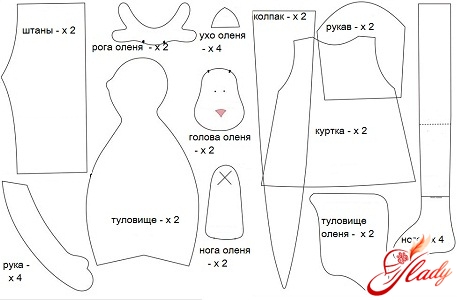 A beard with hair can be made from fur,white synthetic threads or frayed twine. For clothes and felt boots, it is better to use felt. The reindeer's nose is embroidered with pink floss. Santa's legs are cut out together with the shoes. The bottom of the leg is cut out of brown felt boot fabric, the upper part of the leg is made of striped fabric. There is no need to stuff the legs in the hip area, after the knee seam. We recommend reading:
A beard with hair can be made from fur,white synthetic threads or frayed twine. For clothes and felt boots, it is better to use felt. The reindeer's nose is embroidered with pink floss. Santa's legs are cut out together with the shoes. The bottom of the leg is cut out of brown felt boot fabric, the upper part of the leg is made of striped fabric. There is no need to stuff the legs in the hip area, after the knee seam. We recommend reading:




